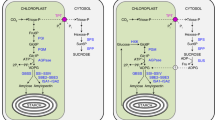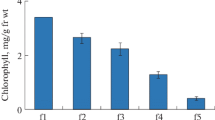Abstract
Isolated amyloplasts from cauliflower (Brassica oleracea L. var botrytis) buds are able to export orthophosphate unidirectionally into the incubation medium. This orthophosphate transport appears to be protein-mediated, as indicated by the following observations: (i) low temperature and the presence of inhibitors of protein-mediated transport reduced the rate of orthophosphate export, and (ii) the rate of orthophosphate export became saturated with rising internal substrate concentrations. Micromolar concentrations of 4,4′-diisothiocyano-2,2′-stilbene disulphonic acid inhibited the rate of unidirectional orthophosphate export, thus indicating the involvement of the amyloplastic glucose-6-phosphate (Glc6P)translocator in the unidirectional export of orthophosphate. The effect of rising concentrations of orthophosphate upon the activity of ADP glucose pyrophosphorylase in desalted extracts was determined. Orthophosphate given in concentrations similar to those measured in the amyloplastic stroma under conditions of steady-state rates of Glc6P-dependent starch synthesis inhibited the activity of ADP-glucose pyrophosphorylase significantly. However, even under strong limiting substrate conditions the residual activity was sufficient to catalyze the flux of carbon into starch. The maximal rates of orthophosphate transport (in the counter-exchange mode) by isolated spinach (Spinacia oleracea L.) chloroplasts and by isolated cauliflower-bud amyloplasts were also determined. These rates were compared with the maximal rates of undirectional orthophosphate export by these plastids. From these measurements we can conclude that, compared with spinach chloroplasts, isolated amyloplasts of cauliflower exhibit a fivefold greater ratio of unidirectional orthophosphate transport to maximal rate of orthophosphate transport in the counter-exchange mode compared to spinach chloroplasts. The determined rate of maximal unidirectional orthophosphate export is sufficient to catalyze the release of additional inorganic phosphate liberated in the amyloplastic stroma during the process of Glc6P-dependent starch synthesis.
Similar content being viewed by others
Abbreviations
- ADPGlcPPase:
-
ADP-glucose pyrophosphorylase
- DIDS:
-
4,4′-diisothiocyano-2,2′-stilbene disulphonic acid
- Glc1P:
-
glucose-1-phosphate
- Glc6P:
-
glucose-6-phosphate
- PGA:
-
3-phosphoglyceric acid
References
Ames BN (1966) Assay of inorganic phosphate, total phosphate and phosphatases. Methods Enzymol 8: 105–127
Backhausen JE, Kitzmann C, Scheibe R (1994) Competition between electron acceptors in photosynthesis: Regulation of the malate valve during CO2 fixation and nitrite reduction. Photosynth Res 42: 75–86
Batz O, Scheibe R, Neuhaus HE (1992) Transport processes and corresponding changes in metabolite levels in relation to starch synthesis in barley (Hordeum vulgare L.) etioplasts. Plant Physiol 100: 184–190
Batz O, Scheibe R, Neuhaus HE (1993) Identification of the putative hexose-phosphate translocator of amyloplasts from cauliflower buds. Biochem J 294: 15–17
Batz O, Scheibe R, Neuhaus HE (1994) Glucose- and ADPGlc-dependent starch synthesis in isolated cauliflower-bud amyloplasts. Analysis of the interaction of various potential precursors. Biochim Biophys Acta 1200: 148–154
Batz O, Scheibe R, Neuhaus HE (1995) Purification of chloroplasts from fruits of green-pepper (Capsicum annuum L.) and characterization of starch synthesis. Evidence for a functional hexosephosphate translocator. Planta 196: 50–57
Borchert S, Große H, Heldt HW (1989) Specific transport of inorganic phosphate, glucose 6-phosphate, dihydroxyacetone phosphate and 3-phosphoglycerate into amyloplasts. FEBS Lett 253: 183–186
Borchert S, Harborth J, Schünemann D, Hoferichter P, Heldt HW (1993) Studies of the enzymic capacities and transport properties of pea root plastids. Plant Physiol 101: 303–312
Coates SA, ap Rees T (1994) Metabolism of glucose monophosphates by leucoplasts and amyloplasts from soybean suspension cultures. Phytochemistry 35: 881–883
Fliege R, Flügge UI, Werdan K, Heldt HW (1978) Specific transport of inorganic phosphate, 3-phosphoglycerate and triose phosphates across the inner membrane of the envelope in spinach chloroplasts. Biochim Biophys Acta 502: 232–247
Gross A, Brückner G, Heldt HW, Flügge UI (1990) Comparison of the kinetic properties, inhibition and labelling of the phosphate translocators from maize and spinach mesophyll chloroplasts. Planta 180: 262–271
Heldt HW, Sauer F (1971) The inner membrane of the chloroplast envelope as the site of specific metabolite transport. Biochim Biophys Acta 234: 83–91
Hill LM, Smith AM (1991) Evidence that glucose 6-phosphate is imported as the substrate for starch synthesis by the plastids of developing pea embryos. Planta 185: 91–96
Journet E-P, Douce R (1985) Enzymic capacities of purified cauliflower bud plastids for lipid synthesis and carbohydrate metabolism. Plant Physiol 79: 458–467
Kosegarten H, Mengel K (1994) Evidence for a glucose 1-phosphate translocator in storage tissue amyloplasts of potato (Solanum tuberosum) suspension-cultured cells. Physiol Plant 91: 111–120
Möhlmann T, Batz O, Maaß U, Neuhaus HE (1995) Analysis of carbohydrate transport across the envelope of isolated cauliflower-bud amyloplasts. Biochem J 307: 521–526
Mouriox G, Douce R (1981) Slow passive diffusion of orthophosphate between intact isolated chloroplasts and suspending medium. Plant Physiol 67: 470–473
Neuhaus HE, Stitt M (1990) Control analysis of photosynthate partitioning. Impact of reduced activity of ADP-glucose pyrophosphorylase or plastid phosphoglucomutase on the fluxes to starch and sucrose in Arabidopsis thaliana (L.) Henyh. Planta 182: 445–454
Neuhaus HE, Henrichs G, Scheibe R (1993a) Characterization of glucose-6-phosphate incorporation into starch by isolated intact cauliflower-bud plastids. Plant Physiol 101: 573–578
Neuhaus HE, Thom E, Batz O, Scheibe R (1993b) Purification of highly intact plastids from various heterotrophic plant tissues. Analysis of enzymic equipment and precursor dependency for starch biosynthesis. Biochem J 296: 496–501
Neuhaus HE, Henrichs G, Scheibe R (1994) Starch degradation in intact amyloplasts from cauliflower buds (Brassica oleracea L.). Planta 195: 496–504
Pozueta-Romero J, Akazawa T (1993) Biochemical mechanism of starch biosynthesis in amyloplasts from cultured cells of sycamore (Acer pseudoplatanus). J Exp Bot 44: Suppl 297–306
Pozueta-Romero J, Frehner M, Viale AM, Akazawa T (1991) Direct transport of ADPglucose by an adenylate translocator is linked to starch biosynthesis in amyloplasts. Proc Natl Acad Sci USA 88: 5769–5773
Preiss J (1993) Biosynthesis of starch: ADPglucose pyrophosphorylase, the regulatory enzyme of starch synthesis: structurefunction relationships. Denpun Kagaku 40: 117–131
Quick PW, Scheibe R, Neuhaus HE (1995) Induction of a hexose phosphate translocator activity in spinach chloroplasts. Plant Physiol 109: 113–121
Rumpho ME, Edwards GE (1985) Evidence for the recognition of 3PGA, PEP and Pi by a common phosphate translocator in C4-chloroplasts using the inhibitor DIDS (4,4′-diisothiocyano-2,2′-disulfonic acid stilbene). Plant Physiol 77: 83–86
Schünemann D, Borchert S, Flügge UI, Heldt HW (1993) ATP/ADP translocator from pea root plastids. Comparison with translocators from spinach chloroplasts and pea leaf mitochondria. Plant Physiol 103: 131–137
Schwarz M, Steinkamp T, Flügge UI, Wagner R (1994) Ion channel properties of the reconstituted chloroplast triose-phosphate/phosphate translocator. J Biol Chem 269: 29481–29489
Sheu-Hwa C-H, Lewis DH, Walker D (1975) Stimulation of photosynthetic starch formation by sequestration of cytoplasmic orthophosphate. New Phytol 74: 383–392
Sowokinos JR (1976) Pyrophosphorylases in Solanum tuberosum. I. Changes in ADPGlucose-and UDPGlucose-pyrophosphorylase activities associated with starch biosynthesis during tuberization, maturation and storage of potatoes. Plant Physiol 57: 63–68
Tetlow IJ, Blisset KJ, Emes MJ (1994) Starch synthesis and carbohydrate oxidation in amyloplasts from developing wheat endosperm. Planta 194: 454–460
Tyson RH, ap Rees T (1988) Starch synthesis by isolated amyloplasts from wheat endosperm. Planta 175: 33–38
Walker D (1992) Energy, plant, and man. Oxygraphics, Packard Publishing, Chichester, UK
Author information
Authors and Affiliations
Corresponding author
Additional information
The authors gratefully acknowledge stimulating discussions on and support for this work by Prof. Dr. Renate Scheibe (Pflanzenphysiologie, Universität Osnabrück, Osnabrück, Germany). We thank Gudrun Henrichs for excellent technical assitance and Dr. Antje von Schaewen for help during preparation of the manuscript. The work was funded by the Deutsche Forschungsgemeinschaft (SFB 171, C16).
Rights and permissions
About this article
Cite this article
Neuhaus, H.E., Maaß, U. Unidirectional transport of orthophosphate across the envelope of isolated cauliflower-bud amyloplasts. Planta 198, 542–548 (1996). https://doi.org/10.1007/BF00262640
Received:
Accepted:
Published:
Issue Date:
DOI: https://doi.org/10.1007/BF00262640




